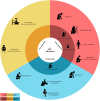The prevalence and risk factors for phantom limb pain: a cross-sectional survey
- PMID: 38321380
- PMCID: PMC10845739
- DOI: 10.1186/s12883-024-03547-w
The prevalence and risk factors for phantom limb pain: a cross-sectional survey
Abstract
Background: We previously performed a systematic review and meta-analysis which revealed a Phantom Limb Pain (PLP) prevalence estimate of 64% [95% CI: 60.01-68.1]. The prevalence estimates varied significantly between developed and developing countries. Remarkably, there is limited evidence on the prevalence of PLP and associated risk factors in African populations.
Methods: Adults who had undergone limb amputations between January 2018 and October 2022 were recruited from healthcare facilities in the Western and Eastern Cape Provinces. We excluded individuals with auditory or speech impairments that hindered clear communication via telephone. Data on the prevalence and risk factors for PLP were collected telephonically from consenting and eligible participants. The prevalence of PLP was expressed as a percentage with a 95% confidence interval. The associations between PLP and risk factors for PLP were tested using univariate and multivariable logistic regression analyses. The strength of association was calculated using the Odds Ratio where association was confirmed.
Results: The overall PLP prevalence was 71.73% [95% CI: 65.45-77.46]. Persistent pre-operative pain, residual limb pain, and non-painful phantom limb sensations were identified as risk factors for PLP.
Conclusion: This study revealed a high prevalence of PLP. The use of effective treatments targeting pre-amputation pain may yield more effective and targeted pre-amputation care, leading to improved quality of life after amputation.
Keywords: Africa; Limb amputations; Phantom limb pain; Prevalence; Risk factors.
© 2024. The Author(s).
Conflict of interest statement
The authors declare no competing interests.
Figures
References
-
- Shatnawi NJ, Al-Zoubi NA, Hawamdeh HM, Khader YS, Garaibeh K, Heis HA. Predictors of major lower limb amputation in type 2 diabetic patients referred for hospital care with diabetic foot syndrome. Diabetes Metabolic Syndrome and Obesity: Targets and Therapy. 2018;11:313. doi: 10.2147/DMSO.S165967. - DOI - PMC - PubMed
Publication types
MeSH terms
LinkOut - more resources
Full Text Sources
Research Materials



